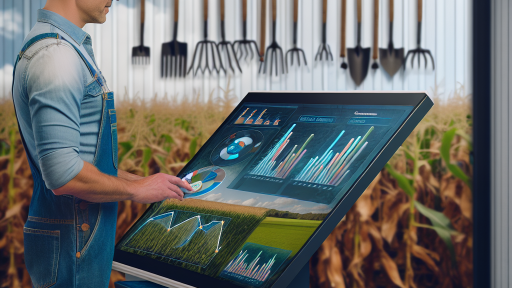Introduction to Market Demand in Agriculture
Understanding market demand is crucial for modern farmers.
It shapes production decisions and influences profitability.
Market demand refers to the total quantity of a product that consumers are willing to buy.
This demand is driven by various factors such as consumer preferences and economic conditions.
Key Components of Market Demand
Several elements contribute to the market demand in agriculture.
Price of the product is a significant factor.
Changes in price can lead to variations in the quantity demanded.
Consumer income also plays a vital role in demand dynamics.
Higher incomes generally lead to increased demand for premium agricultural products.
Impact of Trends on Demand
Modern farmers must keep an eye on changing consumer trends.
For example, an increase in health consciousness affects demand for organic produce.
Moreover, sustainability trends encourage consumers to seek eco-friendly products.
Farmers who adapt to these trends can better meet market demands.
Regional Variations in Demand
Market demand can vary significantly by region.
Urban areas typically show higher demand for fresh produce.
Transform Your Agribusiness
Unlock your farm's potential with expert advice tailored to your needs. Get actionable steps that drive real results.
Get StartedAlternatively, rural regions may prioritize staple crops.
Thus, understanding local preferences is essential for farmers.
Using Data to Analyze Demand
Today, data analysis tools help farmers gauge market demand effectively.
Farmers can leverage sales data and trends to make informed decisions.
Additionally, market research can reveal emerging consumer preferences.
By utilizing data, farmers can adapt their strategies accordingly.
Factors Influencing Market Demand for Agricultural Products
Consumer Preferences
Consumer preferences significantly shape agricultural product demand.
Recent trends show a rise in demand for organic and local produce.
Additionally, health-conscious consumers often prioritize nutritional value.
Consequently, farmers must adapt to changing tastes and preferences.
Technological Advances
Technology enhances agricultural productivity and efficiency.
For instance, precision farming allows farmers to optimize resources.
This optimization results in higher yields and reduced waste.
As a result, advanced technology can positively impact market demand.
Market Access and Distribution
Effective distribution channels are crucial for reaching consumers.
Farmers need reliable logistics to ensure fresh products reach markets.
For example, partnerships with local grocery stores can enhance visibility.
Moreover, online sales platforms have expanded market reach significantly.
Government Policies and Subsidies
Government policies directly affect market demand for agricultural products.
Subsidies can encourage farmers to produce specific crops.
This often leads to increased supplies in response to consumer demands.
Furthermore, regulations may promote sustainable agricultural practices.
Global Market Trends
Global market dynamics also influence local agricultural demand.
Shifts in international trade can create opportunities for farmers.
Showcase Your Farming Business
Publish your professional farming services profile on our blog for a one-time fee of $200 and reach a dedicated audience of farmers and agribusiness owners.
Publish Your ProfileFor instance, exports may increase demand for certain crops abroad.
Conversely, import restrictions can protect local markets from competition.
Climate Change and Environmental Factors
Climate change presents challenges to agricultural production.
Extreme weather patterns can disrupt crop yields and availability.
Farmers must adjust practices to ensure sustainability amid these changes.
As consumers become more environmentally conscious, demand may shift.
Identifying Target Markets for Modern Farmers
Understanding Consumer Preferences
Modern consumers increasingly prioritize quality and sustainability.
They seek products that align with their values.
Organic and locally sourced foods are in high demand.
Additionally, transparency about food origins enhances trust.
Recognizing Niche Markets
Niche markets often provide lucrative opportunities for farmers.
For instance, specialty crops like heirloom tomatoes attract specific buyers.
Furthermore, urban farming targets city dwellers seeking fresh produce.
Farmers can also explore gluten-free or allergy-friendly options.
Engaging with Community Supported Agriculture
Community Supported Agriculture (CSA) models foster strong local ties.
Consumers pay upfront for a share of seasonal produce.
This model ensures farmers have predictable income throughout the year.
Moreover, it encourages deeper relationships with local consumers.
Utilizing Online Marketplaces
The digital landscape offers farmers new sales avenues.
Online marketplaces allow access to broader customer bases.
Farmers can showcase their unique offerings through social media.
Moreover, e-commerce platforms simplify order fulfillment processes.
Collaborating with Restaurants and Retailers
Partnering with local restaurants enhances farm visibility.
Chefs often look for fresh, seasonal ingredients.
Additionally, grocery cooperatives support local producers.
Such collaborations boost the local economy while meeting food trends.
Uncover the Details: Data-Driven Market Analysis for Smart Farming
Utilizing Market Research Techniques to Analyze Demand
Understanding Market Research
Market research identifies consumer needs in agriculture.
It helps farmers adapt to changing market conditions.
Furthermore, it offers insights into customer preferences.
Common Research Methods
Surveys provide direct feedback from consumers.
Focus groups allow in-depth discussions on preferences.
Secondary research analyzes existing data for trends.
Implementing Data Collection
Farmers can use online surveys to gather responses quickly.
In-person interviews may yield richer qualitative insights.
Data collection should aim for diverse demographic representation.
Analyzing Collected Data
Data analysis uncovers significant patterns and trends.
Farmers can segment data based on customer groups.
This analysis aids in targeted marketing efforts.
Monitoring Market Trends
Regular monitoring identifies shifts in consumer demand.
Showcase Your Farming Business
Publish your professional farming services profile on our blog for a one-time fee of $200 and reach a dedicated audience of farmers and agribusiness owners.
Publish Your ProfileStaying updated is crucial for maintaining competitiveness.
Farmers should engage with industry reports for insights.
Utilizing Technology in Research
Modern tools enhance the efficiency of market research.
Social media analytics provide real-time consumer feedback.
Moreover, mobile apps gather data from a broader audience.
Uncover the Details: Navigating Commodity Price Fluctuations in Farming
Impact of Consumer Trends on Agricultural Production
Shifts in Consumer Preferences
Modern consumers care deeply about sustainability.
They increasingly choose organic and locally sourced products.
As a result, farmers adapt their production methods to meet this demand.
Moreover, many consumers seek transparency in food sourcing.
This trend drives farmers to share their farming practices openly.
Health Consciousness
Today’s consumers prioritize health and nutrition.
This focus encourages farmers to produce nutrient-dense crops.
Additionally, there is a growing demand for alternative protein sources.
Consequently, farmers explore options like legumes and plant-based proteins.
Such changes promote a diverse and healthy food supply.
Technological Integration
Emerging technologies shape agricultural production significantly.
Farmers leverage data analytics to enhance crop management.
This allows for optimized planting, irrigation, and harvesting strategies.
Furthermore, precision farming promotes resource-efficient practices.
As a result, farmers can meet consumer demand while minimizing waste.
Global Market Influences
Global trends also impact local agricultural systems.
International demand for specialty crops drives diversification.
Farmers may shift production to align with global market needs.
Moreover, trade agreements can create opportunities for exportation.
Therefore, understanding these markets is crucial for modern farmers.
Find Out More: How Vertical Farming Is Disrupting Traditional Agribusiness Models

Role of Technology in Understanding Market Demand
Data Collection and Analysis
Modern farmers leverage technology to collect data effectively.
They use sensors and IoT devices to gather real-time agricultural information.
This data helps farmers understand soil conditions and crop health.
Furthermore, they utilize analytics platforms to interpret gathered data.
These platforms transform raw data into actionable insights.
Market Trend Identification
Technology plays a crucial role in identifying market trends.
Farmers can analyze consumer preferences through social media analytics.
Additionally, tools like Google Trends provide critical insight into search patterns.
By understanding these trends, farmers adapt their production strategies.
This proactive approach enhances their marketing efforts.
Supply Chain Optimization
Smart technologies streamline the supply chain process for farmers.
They utilize blockchain technology for better traceability of products.
This transparency builds trust with consumers and buyers alike.
Showcase Your Farming Business
Publish your professional farming services profile on our blog for a one-time fee of $200 and reach a dedicated audience of farmers and agribusiness owners.
Publish Your ProfileMoreover, farmers can track inventory levels accurately with software tools.
These systems minimize wastage and optimize resource allocation.
Consumer Engagement
Technology fosters direct engagement between farmers and consumers.
Farmers utilize e-commerce platforms to sell products directly.
Social media allows for real-time communication and feedback from consumers.
Additionally, mobile apps help farmers understand customer preferences.
This engagement increases customer loyalty and satisfaction.
Uncover the Details: How to Scale Your Agribusiness for Maximum Revenue
Strategies for Meeting Market Demand in Farming Practices
Adopting Precision Agriculture
Precision agriculture enhances crop productivity and efficiency.
Modern technology enables farmers to use data-driven approaches.
This method includes soil health monitoring and yield mapping.
Farmers can customize irrigation and fertilization based on real-time data.
Utilizing drones for crop inspection can identify issues quickly.
As a result, farmers can make informed decisions for optimal output.
Emphasizing Sustainable Practices
Sustainable farming practices cater to increasing consumer demand for eco-friendly produce.
Crop rotation improves soil fertility and reduces pest infestations.
Cover cropping enhances soil structure and reduces erosion.
Additionally, integrated pest management encourages biodiversity.
This approach minimizes the reliance on chemical pesticides.
Consumers increasingly seek transparency in farming methods.
Strengthening Local Market Engagement
Building relationships with local consumers boosts market presence.
Farmers’ markets foster connections between producers and customers.
Urban agriculture initiatives can also enhance local food supply.
Targeting community-supported agriculture encourages direct sales.
Moreover, social media provides platforms for farmers to share their stories.
This strategy promotes brand loyalty and customer trust.
Incorporating Technology in Supply Chain Management
Technology facilitates efficient supply chain management for farmers.
Utilizing software can optimize inventory and logistics.
This integration reduces waste and streamlines operations.
Additionally, e-commerce platforms provide wider market access.
Farmers can reach customers beyond their local areas.
Consequently, direct-to-consumer sales can increase profitability.
Cultivating Skills and Knowledge Sharing
Continuous education enhances farmers’ expertise in modern techniques.
Online courses and workshops provide valuable insights.
Peer networking fosters knowledge exchange between farmers.
This collaboration leads to innovation in farming practices.
Furthermore, mentorship programs can guide new farmers effectively.
As a result, the farming community becomes stronger and more resilient.
Case Studies of Successful Market Demand Analysis in Farming
Introduction to Market Demand Analysis
Market demand analysis helps farmers identify consumer preferences.
By understanding demand, farmers can adjust their production strategies.
Showcase Your Farming Business
Publish your professional farming services profile on our blog for a one-time fee of $200 and reach a dedicated audience of farmers and agribusiness owners.
Publish Your ProfileThis leads to increased sales and customer satisfaction.
Case Study: Green Valley Organics
Green Valley Organics utilized data analytics to understand market trends.
They surveyed customers to gauge preferences for organic produce.
As a result, they expanded their organic product line significantly.
This approach boosted their revenue by 30% within a year.
Case Study: HarvestHaven Farms
HarvestHaven Farms implemented social media platforms for feedback.
They engaged customers through polls and discussions on Instagram.
This engagement allowed them to tailor their products effectively.
Ultimately, customer loyalty increased, leading to steady sales growth.
Case Study: Sunny Acres Dairy
Sunny Acres Dairy analyzed local market needs through community meetings.
They discovered a rising demand for dairy alternatives.
By introducing plant-based options, they tapped into new customer segments.
Consequently, their market share improved in the region.
Case Study: EcoFarm Cooperative
EcoFarm Cooperative employed seasonal market forecasts for planning.
This ensured they were producing the right crops at the right times.
Such strategic planning minimized waste and maximized profit margins.
Furthermore, it solidified their reputation as reliable suppliers.
Key Takeaways from the Case Studies
- Data-driven decisions help refine product offerings.
- Engagement with customers provides valuable insights.
- Understanding local demand can lead to new opportunities.
- Adaptable strategies enhance long-term viability in the market.
Additional Resources
Modern Small-Scale Farming – Could it Sustain us? Could we …
AI in Agriculture and Farming: Revolutionizing Crop Growth – Intellias




